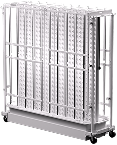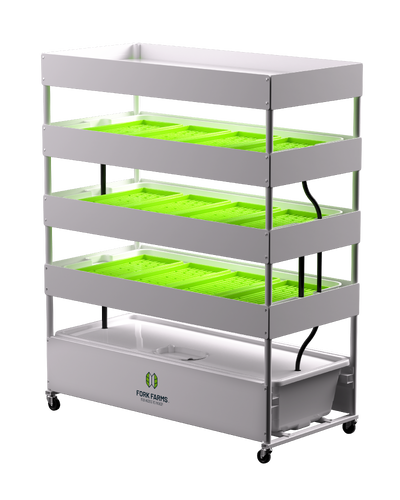Reconnecting the Self: How the Flex Farm Nourishes Body, Mind, and Soul
The Landscape of Disconnection: Food, Education, and the Fractured Self
We are at a point in history where food is both more abundant and more distant than ever before. Most of what we eat comes from highly centralized systems: massive monoculture farms, globalized supply chains, and industrialized processing centers. This system is no doubt impressive - it has produced cheap calories at scale to support a growing population, and it has given us an explosive amount of choice about what we eat and when we can eat it (long gone are the days of waiting until July to eat tomatoes). But this power has come at great expense - it has distanced us from the act of growing, from the rhythms of the land, and from the knowledge of how food actually becomes food.
We’ve disconnected from the act of growing so completely that most of us think of food as a product, not a process.
This is not a logistical issue; it is a spiritual one.
When we don’t know where our food comes from, when we are disconnected from the processes that determine our physical sustenance, we lose a sense of rootedness in the world. This rootedness is what connects us to others, to ourselves, and to purpose. When our relationship to food is as passive consumers, we risk forming the same relationship to learning, to labor, and to life itself, flattening the landscape of agential possibility and narrowing our scope of meaningful engagement.
This doesn’t even begin to address the growing climate volatility and socioeconomic challenges that increasingly threaten the stability of our food system, all of which underscore the urgent need to rethink and rebuild our relationship with food.
But this is only part of the problem.
Our educational system is also confronting a crisis of its own. Chronic absenteeism is rising, student engagement is plummeting, and anxiety, depression, and apathy are increasingly infiltrating the student experience. Students feel disconnected from school, from the community, and from their future. The age of accelerating AI has the potential to disrupt our economic system more than anything humanity has ever experienced, and students are right to wonder: “What am I being prepared for?”
This disconnection is a manifestation of something deeper: a breakdown in the structures that give life coherence. Without a meaningful trajectory, without a sense of belonging, without a connection to the world that grounds the self, students are left with little to hold onto. This is not just a crisis of motivation; it is a crisis of orientation.
How might we attend to this crisis?
The Flex Farm as a Practice of Reconnection
If the crisis is disconnection, then the remedy must be to reconnect. This must not merely be an intellectual exercise, but a practice that engages students on all levels of their being. From hands-on interaction that connects the body, to engaging content that connects the mind, to real-world applications that connect the soul, lessons in the classroom must be oriented to actualize student self-development in a holistic manner.
The Flex Farm offers exactly that.

At its core, it is a compact, uber-efficient hydroponic growing system. When placed in classrooms, it becomes a living laboratory for cultivating care, curiosity, and connection. In tending to plants, students learn to tend to themselves, to their peers, and to their greater community. Whether growing for the cafeteria or donating to the food bank, the Flex Farm allows students to enact their education in ways that transform themselves and the world.
Reconnecting the Body
On one level, the Flex Farm is a hyper-local, healthy-food production machine. Students don’t simply learn about plant biology, environmental science, or food production; they engage in the whole process. They mix nutrients, test pH, transplant seedlings, and track growth. They observe cause and effect in real time, develop and test hypotheses, and experience the satisfaction of harvest. This is learning that lives in the hands as much as the head.
The physiological benefits of interacting with nature are well-known, as is the importance of a healthy diet for student success. The Flex Farm provides daily exposure and ample access to both of these; with 288 plant spaces and the power to grow 25 pounds of fresh food per month, the whole class can have their hand in growing (and eating). In a world where so much is virtual, the Flex Farm invites students into a direct, embodied relationship with the real.
Reconnecting the Mind
The lessons surrounding food production do not live in a silo - they sit at the nexus of nearly every discipline that makes up a well-rounded education, from economics and history to nutrition and biology to chemistry and botany. Having students view these subjects through the lens of the most fundamental human question - how are we going to nourish our bodies - both grounds their significance and reveals their interdependence. As these subjects reconnect to each other, they become more intelligible, rich, and alive.
The Flex Farm does more than teach students about plants; it reframes how they engage with learning at a fundamental level. It trains students to notice, to wonder, and to ask deeper questions. When students have this type of orientation, a different type of learning becomes possible.
Reconnecting the Soul
The soul is where purpose, belonging, and value converge. It is nourished when a student’s efforts ripple outward and matter to others, when learning in the classroom is not only connected to real-world issues but actually moves the world. With the Flex Farm, stewardship is not abstract - it is put into practice. Students cultivate living things that, in turn, cultivate community.
Imagine a harvest day when bunches of basil are handed over to the culinary class, or bags of greens are delivered to a local food pantry. In those moments, the work of the classroom becomes a gift, and the giver discovers themself as a contributor, not merely a consumer. This experience of meaningful contribution re-enchants the educational journey: learning is no longer a chore, it is a chance to matter.
-1.jpg?width=1200&length=1200&name=Two%20Students%20at%20desk%20(1)-1.jpg)
A Living Path Forward
Our food and learning crises aren’t technical breakdowns so much as losses of intimacy. True repair requires practices that draw students back into genuine participation with the world and with one another.
The Flex Farm is one such practice. It reconnects the body through action and nourishment, the mind through interdisciplinary wonder, and the soul through shared purpose and care.
In short, it offers a way to return and reconnect to rhythm, to relationship, and to reality. In that return, students don’t just grow food, they grow themselves; and with each harvest, they help cultivate a culture of care that our fractured world urgently needs.
Article by: Ben Block, Fork Farms























